All Things Aquatics and DIY aAquarium Hobby
Amphiprion bicinctus (Two-band Clownfish)
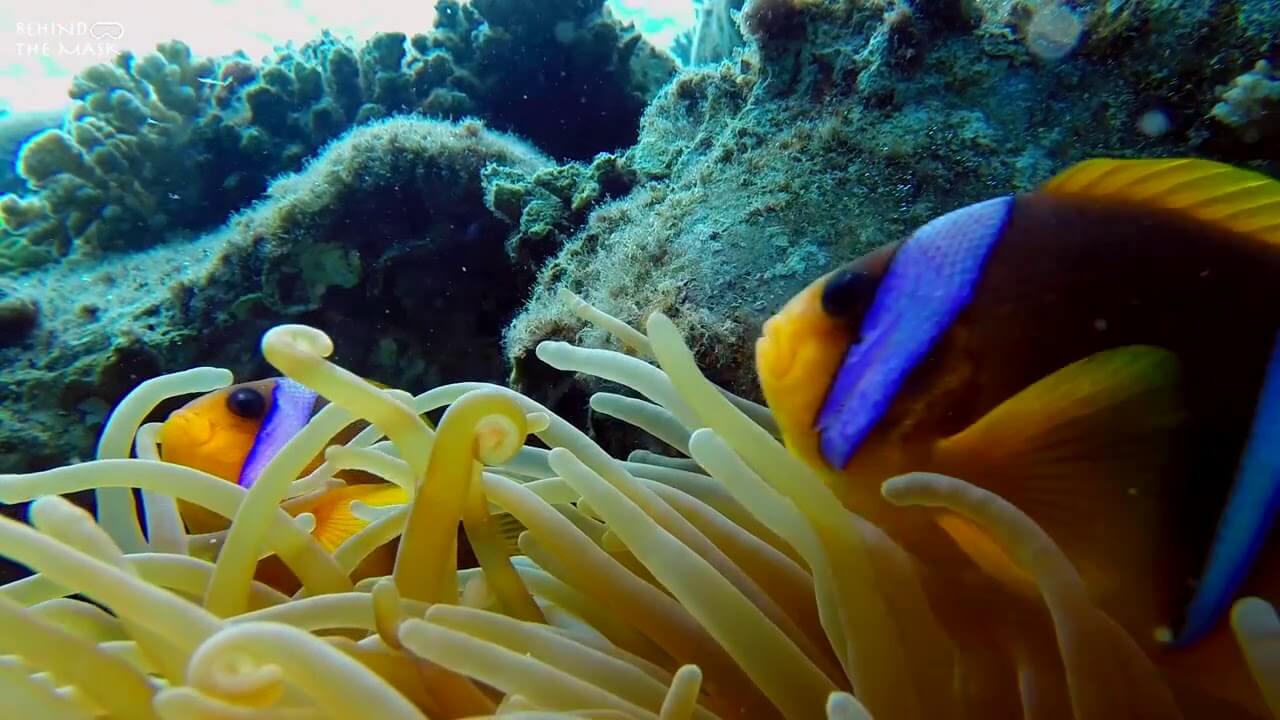
Meet -
Two-band Clownfish
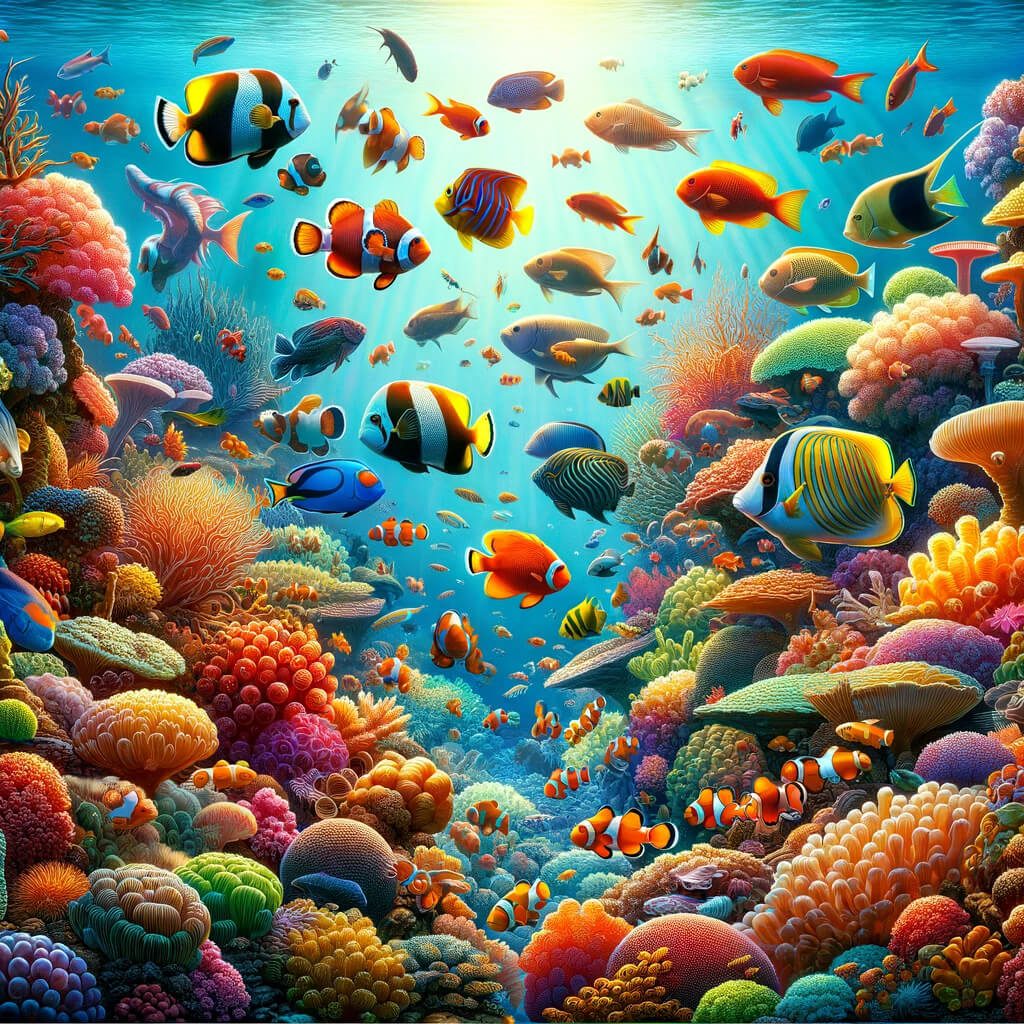
Species Characteristics
Greetings, fellow marine enthusiasts! Today, we're diving into the fascinating world of the Amphiprion bicinctus, commonly known as the Two-band Clownfish. Join us as we explore this captivating clownfish species, its unique characteristics, and its important role in marine biodiversity.
Whether you're a seasoned aquarist or a beginner in saltwater aquariums, the Two-band Clownfish is undoubtedly a species worth knowing.
Key Takeaways:
-
- Amphiprion bicinctus, or the Two-band Clownfish, is a captivating species found in the warm waters of the Indian Ocean and the Red Sea.
-
- These clownfish have a distinctive coloration, with a reddish-brown to orange body and two broad white bands encircling their body.
-
- The Two-band Clownfish forms a mutualistic relationship with certain species of sea anemones, providing food and protection in return for refuge amongst the anemone's tentacles.
-
- Understanding the taxonomy, natural habitat, and distribution of the Two-band Clownfish is essential for creating suitable marine aquarium setups.
-
- The Two-band Clownfish is beginner-friendly and adds vibrancy to marine aquariums, making it a popular choice among aquarists.
Table of Contents
Introduction Two-band Clownfish
In this section, we will explore the taxonomy and classification of the Two-band Clownfish and its natural habitat and distribution.
Taxonomy and Classification
The Two-band Clownfish belongs to the genus Amphiprion and the family Pomacentridae. Understanding the taxonomy and classification of this species is essential for marine aquarium enthusiasts and hobbyists.
Natural Habitat and Distribution
The Two-band Clownfish is native to the Western Indian Ocean, the Red Sea, Socotra, and the Chagos archipelago. These vibrant and colourful fish have a natural affinity for coral reefs, forming a mutualistic relationship with specific species of sea anemones.
These clownfish seek refuge among the tentacles of sea anemones while providing food and protection in return. Some of the preferred host anemone species include Entacmaea quadricolor, Heteractis aurora, Heteractis crispa, Heteractis magnifica, and Stichodactyla gigantea.
Understanding the two-band clownfish’s natural habitat and distribution is crucial when creating suitable marine aquarium setups that mimic their natural environment. By recreating their preferred habitat, enthusiasts can provide these fish with optimal living conditions, promoting their well-being and overall health.
Physical Description and Characteristics
Welcome to the fascinating world of the Two-band Clownfish! This section will delve into the physical description, colours, markings, gender differences, and behaviour of this captivating species. Prepare to be amazed by the unique features that make the Two-band Clownfish a favourite among marine enthusiasts.
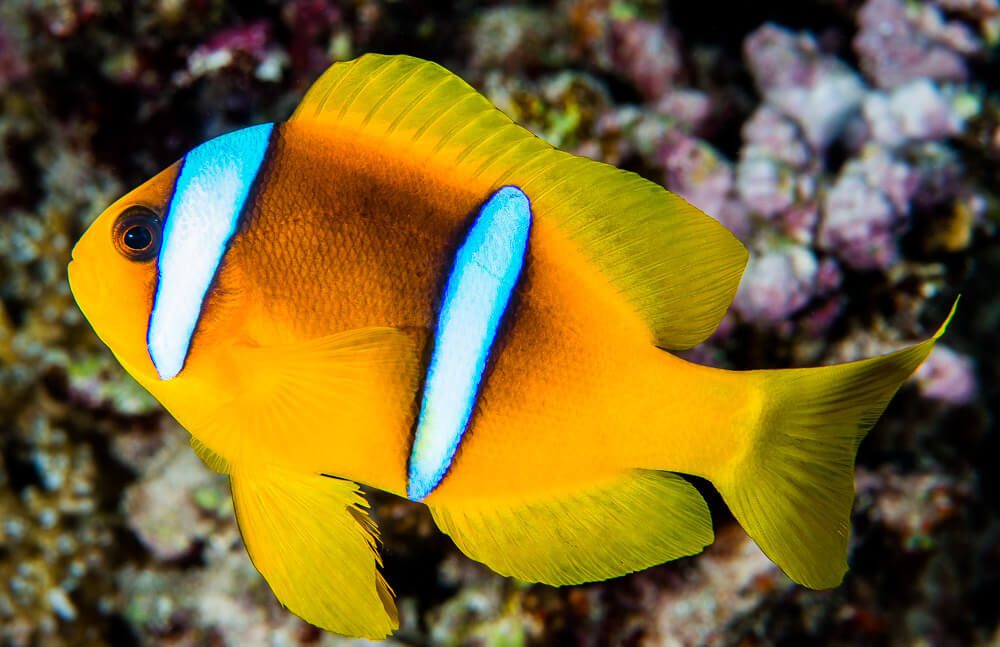
Colours and Markings
One of the most striking characteristics of the Two-band Clownfish is its vibrant colouration. These clownfish have mustard yellow or dark orange bodies adorned with two distinctive white bands encircling their body. The head-bar, which runs across their face, is considerably wider, enhancing their charm.
The contrasting colours of the Two-band Clownfish add visual appeal to marine aquarium setups and serve as a defence mechanism. The vivid hues help these fish blend in with the vibrant colours of their host anemones, offering camouflage and protection against potential predators.
Gender Differences
When it comes to gender, the Two-band Clownfish exhibits distinct differences. The males are generally smaller, reaching a length of around 10 centimetres, while females can grow up to 14 centimetres. In addition to size variations, males display brighter colours and more prominent head bars, making them easily distinguishable from females.
Varieties
The Two-band Clownfish species encompasses different color variations that further add to its allure. While the predominant colouration is mustard yellow or dark orange, variations like the “Midas” or “gold stripe,” which exhibit lighter shades of yellow or orange, allow aquarists to create diverse and visually captivating aquarium displays.
Grades
When grading the Two-band Clownfish, several factors come into play. These include colour intensity, pattern clarity, and overall body proportion. Higher-grade individuals exhibit more vibrant colours, well-defined patterns, and uniform body proportions, making them highly sought after by hobbyists and collectors.
Behaviour and Temperament
Known for their lively and playful nature, Two-band Clownfish add vibrancy and charm to any marine aquarium. They are highly active reef dwellers, constantly exploring their surroundings and engaging in various social interactions. These clownfish display fascinating symbiotic behaviour with certain species of sea anemones, seeking refuge among the anemone’s tentacles while providing food and protection in return.
The Two-band Clownfish are well-known for their beginner-friendly temperament, making them an excellent choice for saltwater aquarium enthusiasts of all experience levels. They are generally peaceful and can thrive in community tanks with compatible tank mates, such as other clownfish species, dottybacks, gobies, and certain species of damselfish. Their adaptable and social nature enhances the overall dynamics of the aquarium ecosystem, creating a captivating and harmonious underwater environment.
Aquarium Requirements
Understanding the two-band clownfish’s specific requirements is essential for providing a suitable living environment in a home reef aquarium. This section will outline the ideal tank size and layout, the necessary water parameters, suitable tank mates, and the clownfish’s compatibility with live plants and invertebrates.
Ideal Tank Size and Layout
The ideal tank size for a pair of Two-band Clownfish is a minimum of 26 gallons (113 litres). A larger tank with more swimming space is always recommended to ensure the clownfish have ample room to explore and exhibit their natural behaviours. When designing the tank’s layout, it’s essential to provide hiding spots and open areas for the clownfish to swim freely. Adding live rock structures and coral formations can create an aesthetically pleasing and stimulating environment for the clownfish.
Water Parameters
Maintaining the appropriate water parameters is crucial for the well-being of the Two-band Clownfish. The recommended temperature range for their tank is 75-82°F (24-28°C), and the salinity should be kept between 1.023-1.025. The pH level should also be maintained within the range of 8.1-8.4. Regular monitoring of these parameters is essential to ensure a stable and healthy marine environment for the clownfish.
Suitable Tank Mates and Potential Conflicts
When selecting tank mates for the Two-band Clownfish, it’s essential to choose compatible species that won’t threaten the clownfish. Suitable tank mates include other peaceful and non-aggressive fish species, such as gobies, blennies, and damselfish.
However, avoiding keeping the clownfish with more significant, aggressive fish that may intimidate or harm them is important. Additionally, it’s best to prevent housing multiple clownfish species together, as they may exhibit territorial behaviour and potentially engage in conflicts.
Compatibility with Live Plants and Invertebrates
The Two-band Clownfish can be kept in a reef tank with live plants and invertebrates, but careful consideration must be given to their compatibility. Some species of live plants and invertebrates may not tolerate the constant presence of clownfish and the disruption they may cause to the natural balance of the tank.
It’s essential to research and select marine plants and invertebrates that can thrive in the presence of clownfish and can withstand their activity levels.
Overall, meeting the specific aquarium requirements of the Two-band Clownfish is essential for their health and well-being in a home reef aquarium.
Suitable tank size and layout, maintaining the proper water parameters, selecting compatible tank mates, and ensuring compatibility with live plants and invertebrates are critical factors in creating a thriving reef tank for these captivating fish.
Two-band Clownfish – Care
In this section, we provide essential care tips for maintaining the health and well-being of the Two-band Clownfish in a home reef aquarium.
Proper care is crucial for ensuring the longevity and vitality of these delightful fish. By following these guidelines, aquarists can create a suitable environment that promotes the well-being of their clownfish.
Diseases
Like all saltwater fish, clownfish are susceptible to certain diseases. It is essential to be aware of common illnesses affecting these fish and take preventive measures to ensure their health.
Regularly monitoring your clownfish and their environment is vital to detect any signs of disease early on. Prompt action and appropriate treatment can significantly increase the chances of a full recovery.
Some common saltwater aquarium diseases that can affect clownfish include:
- Marine Ich (Cryptocaryon irritans): This parasitic disease manifests as white spots on the fish’s body, fins, and gills. It can cause irritation, loss of appetite, and eventual death if left untreated.
- Fin Rot Is a bacterial infection that causes the deterioration of the fish’s fins, leading to fraying or loss. It is often a result of poor water quality or fin-nipping by tank mates.
- Brooklynella: Also known as Clownfish Disease, this parasitic infection causes rapid breathing, excessive mucus production, and the appearance of white patches on the skin. If not treated promptly, it can be fatal.
- Velvet (Amyloodinium ocellatum): This parasitic infection manifests as a yellowish or golden dusting on the fish’s body and fins. It can lead to lethargy, loss of appetite, and difficulty breathing.
- Mouth Fungus (Columnaris): A bacterial infection that affects the fish’s mouth, causing the appearance of white cotton-like growths. It can lead to difficulty eating and respiratory issues.
Preventing these diseases involves maintaining optimal water quality, providing a well-balanced diet, and carefully quarantining any new fish before introducing them to an established aquarium.
Regularly testing water parameters, performing partial water changes, and ensuring proper filtration are essential for maintaining a healthy environment for your clownfish.
Diet and Feeding
Dietary Preferences
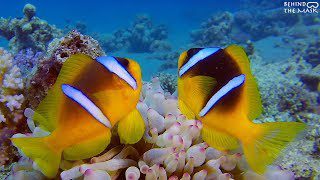
The Two-band Clownfish has specific dietary preferences contributing to its overall health and well-being. These clownfish are omnivorous, consuming animal and plant-based food sources. In the wild, their diet primarily consists of small invertebrates, such as copepods, amphipods, and brine shrimp.
Additionally, they also consume algae and other forms of plant matter.
When keeping Two-band Clownfish in a home reef aquarium, it is essential to replicate their natural diet as closely as possible. A varied and balanced diet is necessary to meet their nutritional requirements and support their vibrant colouration and energy levels.
Recommended Foods and Feeding Schedule
Various commercially available fish foods explicitly formulated for clownfish can be used to ensure a well-rounded diet. These include high-quality pellet or flake foods specifically designed for marine fish and frozen or freeze-dried foods such as brine shrimp, mysis shrimp, and enriched live foods.
Aim to feed the Two-band Clownfish 1-2 times a day, offering an amount of food they can consume within a few minutes. It is important not to overfeed them, as excess uneaten food can contribute to poor water quality and health issues. Observing their feeding behaviour can help determine the appropriate amount of food to provide.
Tips on Ensuring a Balanced and Nutritious Diet
- Include a mix of dry and frozen/live food sources to provide diverse nutrients.
- Pay attention to the quality of the food you provide. Look for reputable brands and select options formulated explicitly for saltwater fish.
- Consider offering natural food sources, such as live copepods or macroalgae, to mimic their natural feeding behaviour.
- Monitor the clownfish’s appetite and adjust the feeding schedule accordingly. If they appear less interested in eating, it may indicate a change in their health or condition.
- Regularly test and maintain proper water quality to support optimal digestion and nutrient absorption.
By following these tips and providing a varied and nutritious diet, you can ensure the Two-band Clownfish thrives in your home reef aquarium and displays its vibrant colours and energetic behaviour.
Breeding and Reproduction
The breeding and reproduction of Two-band Clownfish are fascinating processes that can be explored in a home reef aquarium. Understanding the intricacies of sexing these fish and creating suitable breeding conditions are essential for successful reproduction.
Additionally, caring for the eggs and fry requires careful attention and consideration. However, breeding Two-band Clownfish in captivity can pose some challenges discussed in this section. Let’s delve into the world of breeding and reproduction to discover the wonders of these captivating fish.
Sexing
Sexing Two-band Clownfish involves identifying the differences between males and females. Males tend to be smaller and have more elongated dorsal fins, while females are more significant and possess rounder bodies.
Additionally, males may exhibit more vibrant colouration compared to females. By closely observing their physical characteristics and behaviours, aquarists can determine the sex of these fish and establish a dominant breeding pair within a group.
Breeding Behavior and Conditions
The breeding behaviour of Two-band Clownfish is complex and dynamic. These fish form monogamous pairs and display courtship rituals, such as mutual circling and aggressive behaviours towards intruders. To encourage successful reproduction, it is crucial to provide suitable breeding conditions in the aquarium.
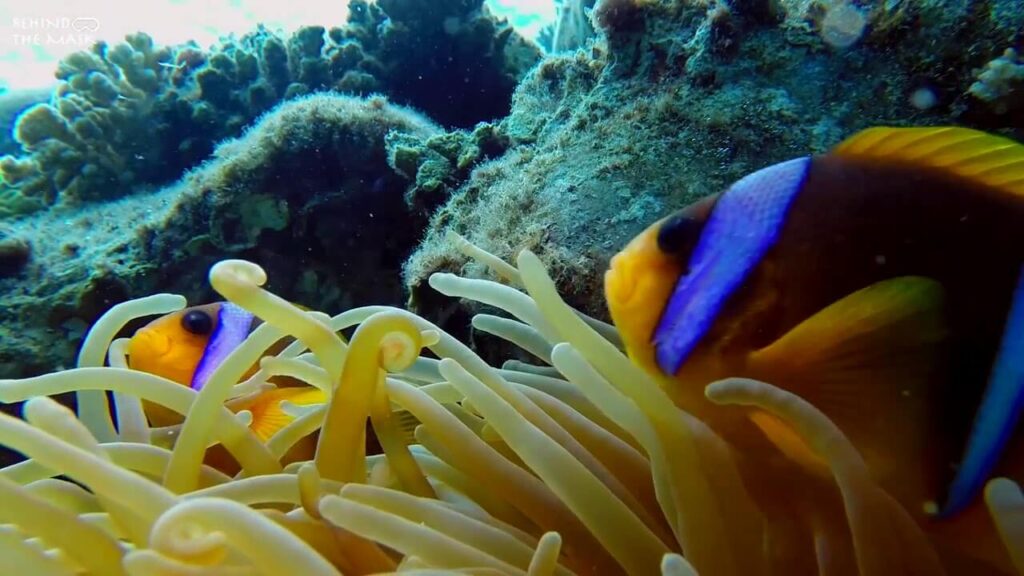
This includes maintaining stable water parameters, providing ample hiding spots, and ensuring the presence of a compatible host anemone. A well-prepared and supportive environment enhances the chances of breeding success.
Care of Eggs and Fry
Once breeding occurs, caring for eggs and fry becomes essential. Two-band Clownfish lay their adhesive eggs on a solid substrate close to the host anemone. It is crucial to monitor the eggs closely, ensuring sufficient water flow and removing any fungus or debris that may accumulate.
The fry will hatch after several days, and their diet should consist of suitable food options such as rotifers and tiny zooplankton. Providing adequate nutrition and maintaining optimum water conditions are critical for the survival and growth of the fry.
Challenges in Breeding in Captivity
Breeding Two-band Clownfish in captivity can present various challenges. One common hurdle is finding a compatible host anemone, as not all anemone species are suitable for these clownfish.
Furthermore, maintaining stable water conditions, including temperature, salinity, and pH levels, can be demanding. Additionally, successful breeding often requires an experienced aquarist who closely monitors the breeding pair and properly cares for the eggs and fry.
Overcoming these challenges is a rewarding accomplishment for dedic
Summary
In summary, the Two-band Clownfish, scientifically known as Amphiprion bicinctus, is a fascinating clownfish found in the warm waters of the Indian Ocean and the Red Sea.
With its distinctive reddish-brown to orange body and two prominent white bands, this clownfish adds vibrant color to marine aquarium setups. It belongs to the genus Amphiprion and forms a mutualistic relationship with certain species of sea anemones, providing them with food and protection.
Understanding the taxonomy, natural habitat, and distribution of the Two-band Clownfish is crucial for creating suitable marine aquarium setups.
These clownfish prefer specific sea anemone species, such as Entacmaea quadricolour and Stichodactyla gigantea. They thrive in reef tank environments and can be a valuable addition to a beginner-friendly saltwater aquarium.
When caring for the Two-band Clownfish, providing an ideal tank size and layout with ample hiding spots is essential. Maintaining appropriate water parameters, such as temperature, salinity, and pH levels, is crucial for their health and well-being. Additionally, suitable tank mates should be chosen to avoid conflicts, and the compatibility of live plants and invertebrates with the clownfish should be considered.
Feeding the Two-band Clownfish a balanced and nutritious diet is essential. They prefer small invertebrates and algae; a suitable feeding schedule should be established. By following proper care practices, including regular monitoring and disease prevention, aquarists can create a thriving environment for these captivating fish.
In conclusion, with its distinct appearance and engaging behaviour, the Two-band Clownfish is a valuable addition to saltwater aquariums. By adhering to responsible and sustainable marine aquarium practices, we can appreciate the beauty of this species while contributing to marine biodiversity conservation.
Source Links
FAQ's
What is the scientific name of the Two-band Clownfish?
The scientific name of the Two-band Clownfish is Amphiprion bicinctus.
Where is the Two-band Clownfish found in the wild?
The Two-band Clownfish is found in the warm waters of the Indian Ocean and the Red Sea.
What are the distinctive characteristics of the Two-band Clownfish?
The Two-band Clownfish has a reddish-brown to orange body with two broad white bands encircling its body.
Are Two-band Clownfish suitable for beginner saltwater aquariums?
Yes, Two-band Clownfish are considered beginner-friendly saltwater fish due to their adaptability and ease of care.
What size tank is recommended for keeping Two-band Clownfish?
To provide adequate space for Two-band Clownfish, a tank size of at least 20 gallons is recommended.
What water parameters should be maintained for Two-band Clownfish?
Two-band Clownfish prefer a temperature range of 75 to 80 degrees Fahrenheit, salinity level between 1.023 and 1.025, and a pH level of 8.1 to 8.4.
Can Two-band Clownfish live with other fish in a reef tank?
Two-band Clownfish can coexist with a variety of other peaceful fish species, but compatibility should be carefully considered to avoid aggression or territorial conflicts.
Do Two-band Clownfish need a sea anemone in their tank?
Two-band Clownfish do not require a sea anemone to thrive in captivity. They can adapt well to aquarium life without hosting in anemones.
What is the ideal diet for Two-band Clownfish?
Two-band Clownfish are omnivorous and should be fed a balanced diet consisting of high-quality commercial fish foods, supplemented with small invertebrates and algae.
Can Two-band Clownfish be bred in a home aquarium?
Yes, it is possible to breed Two-band Clownfish in a home aquarium with careful planning and proper conditions, but it may require experience and expertise.
How can I prevent diseases in Two-band Clownfish?
Maintaining excellent water quality, providing a balanced diet, and quarantining new additions to the tank can help prevent common saltwater fish diseases in Two-band Clownfish.
